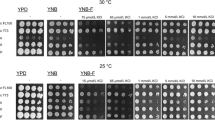Abstract
A strain of Saccharomyces cerevisiae has been adapted to increasing concentrations of copper at two different pH values. The growth curve at pH 5.5 is characterized by a time generation increasing with the amount of added copper. A significant decrease of cell volume as compared with the control is also observed. At pH 3 the cells grow faster than at pH 5.5 and resist higher copper concentrations (3.8 against 1.2 mm). Experimental evidence indicates that, after copper treatment, the metal is not bound to the cell wall, but is localized intracellularly. A significant precipitation of copper salts in the medium was observed only at pH 5.5. Increased levels of superoxide dismutase (SOD) activity were observed in copper-treated cells and which persisted after 20 subsequent inocula in a medium without added metal. On the contrary, catalase activity was not stimulated by copper treatment and, hence, not correlated with SOD levels. The mechanism of copper resistance, therefore, probably involves a persistent induction of SOD, but not of catalase, and it is strongly pH-dependent.
Similar content being viewed by others
References
Butt TR, Sternberg EJ, Gorman JA, et al. 1984 Copper metallothionein of yeast, structure of the gene, and regulation of expression. Proc Natl Acad Sci USA 81, 3332–3336.
Carri MT, Galiazzo F, Ciriolo MR, Rotilio G. 1991 Evidence for co-regulation of Cu,Zn superoxide dismutase and metallothionein gene expression in yeast through transcriptional control by copper via the ACE1 factor. FEBS Lett 278, 263–266.
Foster PL. 1977 Copper exclusion as a mechanism of heavy metal tolerance in a green alga. Nature 269, 322–323.
Freedman JH, Ciriolo MR, Peisach J. 1989 The role of glutathione in copper metabolism and toxicity. J Biol Chem 264, 5598–5605.
Galiazzo F, Schiesser A, Rotilio G. 1987 Glutathione peroxidase in yeast. Presence of the enzyme and induction by oxidative conditions. Biochem Biophys Res Commun 147, 1200–1205.
Galiazzo F, Ciriolo MR, Carri MT, et al. 1991 Activation and induction by copper of Cu/Zn superoxide dismutase in Saccharomyces cerevisiae. Eur J Biochem 196, 545–549.
Gralla EB, Thiele DJ, Silar P, Valentine JS. 1991 ACE1, a copper-dependent transcription factor, activates expression of the yeast copper, zinc superoxide dismutase gene. Proc Natl Acad Sci USA 88, 8558–8562.
Greco MA, Hrab DI, Magner W, Kosman DJ. 1990 Cu, Zn Superoxide dismutase and copper deprivation and toxicity in Saccharomyces cerevisiae. J. Bacteriol 172, 317–325.
Harris ED. 1991 Copper transport: an overview. Proc Soc Exp Biol Med 196, 130–140.
Huges MN, Poole RK. 1991 Metal speciation and microbiol growth: the hard (and soft) facts. J Gen Microbiol 137, 725–734.
Klotz IM, Klotz TA. 1955 Oxygen-carrying proteins: a comparison of the oxygenation reaction in Hemocyanin and Hemerythrin with that in Hemoglobin. Science 121, 477–480.
Lawrence AR, Burk RF. 1976 Glutathione peroxidase activity in selenium-deficient rat liver. Biochem Biophys Res Commun 71, 952–958.
Manzano M, Romandini P, de Bertoldi M, Beltramini M, Salvato B, Cozzani I. 1993 Interaction among heavy metals and methanol affecting superoxide dismutase activity in Saccharomyces cerevisiae. Comp Biochem Physiol 105C, 175–178.
Michelson AM, Puget K, Durosay P, Nonneau JC. 1977 Clinical aspects of the dosage of erythrocuprein. In: Michelson AM, McCord J, Fridovich I, eds. Superoxide and Superoxide Dismutase. London: Academic Press; 467–499.
Peterson GL. 1977 A simplification of the protein assay method of Lowry et al. which is more generally applicable. Anal Biochem 83, 346–356.
Puget K, Michelson AM. 1974 Iron containing superoxide dismutases from luminous bacteria. Biochimie 56, 1255–1267.
Romandini P, Tallandini L, Beltramini M, et al. 1992 Effects of copper and cadmium on growth, superoxide dismutase and catalase activities in different yeast strains. Comp Biochem Physiol 103C, 255–262.
Thiele DJ. 1992 Metal-regulated transcription in eukaryotes. Nucleic Acid Res 20, 1183–1191.
Author information
Authors and Affiliations
Rights and permissions
About this article
Cite this article
Sarais, I., Manzano, M., De Bertoldi, M. et al. Adaptation of a Saccharomyces cerevisiae strain to high copper concentrations. Biometals 7, 221–226 (1994). https://doi.org/10.1007/BF00149552
Received:
Accepted:
Issue Date:
DOI: https://doi.org/10.1007/BF00149552




